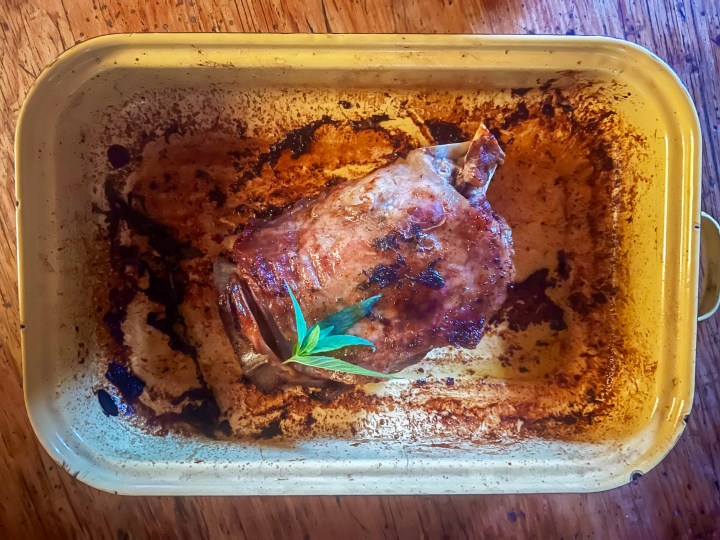A CLASSIC UPDATED
Throwback Thursday: Lamb with mint, two ways

Anyone who grew up with roast leg of lamb on Sundays, served with traditional British mint sauce, will be taken straight back to their childhood with one whiff of it in the air. But this week I updated it, using the delectable cut that is lamb shoulder, rather than the traditional leg, and roasted it with minted butter.
Old recipes come and old recipes go, sometimes with relief, at other times regretfully. But when a recipe just keeps hanging around, enduring the slings and arrows of those who cannot live without change, and surviving competition from anything from bao to banting, there’s usually a good reason for it. One of the best examples of the latter is the old English tradition of roast lamb and mint sauce, often served for Sunday lunch.
And the reason, it is posited, why lamb and mint sauce just will not leave the culinary stage is: science.
Cook’s Illustrated shares the results of a scientific investigation into why certain foods seem to pair so well with others. The results, with regard to lamb and mint sauce, are fascinating.
In essence (a very good choice of word in this instance), it is explained, certain foods make others they are matched with taste even better. This is undeniably true of roast lamb and mint sauce. The perk of the herby flavour of mint with its aniseed spike, the tang of vinegar and the sweetness of sugar work a minor miracle when eaten with a succulent morsel of roast lamb. And the mint, when eaten with salted lamb with its caramelised exterior, somehow becomes more of itself.
Cook’s Illustrated points out, first, that roast lamb “has a flavour unlike any other cooked meat, distinguished by the release of volatile aroma compounds in the fat during cooking. The majority of these compounds are branched-chain fatty acids (BCFAs).”
Mint, meanwhile, “is rich with branched-chain ketones, which are chemically related to lamb’s BCFAs and have similar, though not identical, aromas. This means, according to the theory of food pairing, that lamb and mint are a scientific match. They add that the dominant flavour compounds in mint are not found in other herbs, such as tarragon or basil.”
Scientists, who aren’t always quite this interesting when discussing foods, add: “In addition, researchers have found another interesting compound in lamb that originates from the animal’s diet. This compound, called 2,3-octanedione, is formed when the lamb consumes fresh clover and ryegrass. It is stored in the lamb’s fat and, according to this theory, chemically bridges the gap between the BCFAs and the branched-chain ketones, with a similar sweet, fruity aroma that complements the aroma of mint.”
Of course, in the Karoo they will be eating karoobossies such as kapokbos (wild rosemary).
The British tradition of mint sauce is thought to go back to mediaeval times, with one supposition being that Queen Elizabeth I issued a decree that lamb and mutton be eaten with bitter herbs, in an attempt to curb consumption and protect the wool trade. Crafty cooks began making a sweetened mint sauce to curb the supposed bitterness of mint.
Today, sometimes a squeeze of fresh lime or lemon juice is added. In others, different types of vinegar are employed. Some are even finished with cream. But lamb (I must protest) does not benefit from cream.
There are pockets of wry observation and insight into the mint sauce tradition that go back generations.
The Book of Household Management, edited by Isabella Beeton (1861) carried a recipe for “MINT SAUCE, to serve with Roast Lamb”:
Ingredients. – 4 dessertspoonfuls of chopped mint, 2 dessertspoonfuls of pounded white sugar, 1/4 pint of vinegar.
Mode. – Wash the mint, which should be young and fresh-gathered, free from grit; pick the leaves from the stalks, mince them very fine, and put them into a tureen; add the sugar and vinegar, and stir till the former is dissolved. This sauce is better by being made 2 or 3 hours before being wanted for the table, as the vinegar then becomes impregnated with the flavour of the mint. By many persons, the above proportion of sugar would not be considered sufficient; but as tastes vary, we have given the quantity which we have found to suit the general palate.
Average cost, 3d.
Sufficient to serve with a middling-sized joint of lamb.
Note. – Where green mint is scarce and not obtainable, mint vinegar may be substituted for it, and will be found very acceptable in early spring.
The House-keepers Pocket-Book (1760) boasted a recipe headlined “To Roast the Hind Quarter of a Pig, Lamb-fashion” which was, yes, not for lamb but for pork, but roasted as if it were lamb. An entire hind quarter of it!:
At the Time of Year when House-Lamb’s very dear, take the Hind Quarter of a large Pig, take off the skin, and roast it, and it will eat like Lamb, with Mint-Sauce, or with a Sallad, or Seville Oranges.”
Mint Sauce.
Wash your mint perfectly clean from grit or dirt, then chop it very fine, and put to it vinegar and sugar.
A recipe for mint sauce in Ethel Meyer’s 1200 ENGLISH RECIPES (1898) called for:
“2 T of finely chopped mint leaves, 1T of granulated sugar (American) or castor sugar (British), and 6 T vinegar. After mixing the mint and sugar, the mixture must sit for an hour; then the vinegar can be added gradually, mixing well between each addition.
Let American writer Charles Farrar Browne (1834-1867) have the last word:
“My wife is one of the best wimin on this Continent, altho’ she isn’t always gentle as a lamb with mint sauce.”
The traditional recipes for roast leg of lamb and mint sauce follow. But first…
Shoulder of lamb with minted butter
(Serves 2 generously)
Ingredients
A handful of fresh mint, chopped finely
Extra mint sprigs for the bottom of the oven dish
4 Tbsp olive oil
⅓ cup butter, at room temperature
Salt to taste
Black pepper to taste
Method
Preheat the oven to 200℃.
Chop the mint finely and whip it into the softened butter, using a fork.
Pour the olive oil into a heavy iron dish on the stove, heat it up, and brown the lamb shoulder well on all sides.
While it is still hot, rub the mint butter all over it on both sides. Salt and pepper it on both sides while you’re working. Pop a few extra mint sprigs underneath the joint.
Roast, uncovered, for 15 minutes at 200℃, then turn the heat down low (about 170℃) and continue to cook for about two-and-a-half hours, or until the meat is beautifully tender.
I served it with buttered spinach cooked with garlic, butter and salt
Roast leg of lamb

Tony Jackman’s traditional British roast leg of lamb, served with mint sauce. Inset: Mint sauce, homemade. (Photos: Tony Jackman)
I roasted a lamb leg, about 2 kg, very simply with olive oil, salt and pepper. The mint sauce does the rest of the work.
Ingredients
1 whole leg of lamb, 1.5 kg to 2 kg
Olive oil
Salt (or garlic salt) and black pepper to taste
Method
Preheat the oven to 180℃. Brush olive oil all over the lamb and season generously with salt and black pepper.
Cook at 180℃ for 20 minutes, then turn the heat down to 160℃ and cook until done to your liking.
The recommended cooking time for roast leg of lamb cooked medium is 25 minutes per 500 g plus 25 minutes more. Medium or medium rare are best for a sizable lamb leg. Rare is just that tad too pink and potentially tough for perfection. Reduce the cooking time by a few minutes if you want it less than medium. Continue towards well done at your own peril.
Leave it to rest with the oven turned off and the door ajar for 20 minutes once it’s done.
Traditional British mint sauce

Homemade mint sauce. (Photo: Tony Jackman)
(Serves 6 to 8)
Ingredients
1 cup of chopped fresh mint, no stems
1 heaped Tbsp sugar
5 Tbsp boiling water
3 Tbsp white wine vinegar
Method
Boil some water and have a small bowl and tablespoon ready. Pour some boiled water into it.
Pick the mint leaves, discarding the stems, and chop them finely.
Put them into a heatproof bowl or jug and sprinkle the sugar over, followed by 5 Tbsp of boiling water. Stir and leave to cool.
Once cooled, stir in the vinegar, cover, and leave to steep for an hour or more.
You can refrigerate it for 10 to 14 days. DM
Tony Jackman is Galliova Food Writer 2023, jointly with TGIFood columnist Anna Trapido.
Follow Tony Jackman on Instagram @tony_jackman_cooks.



 Become an Insider
Become an Insider
Comments - Please login in order to comment.